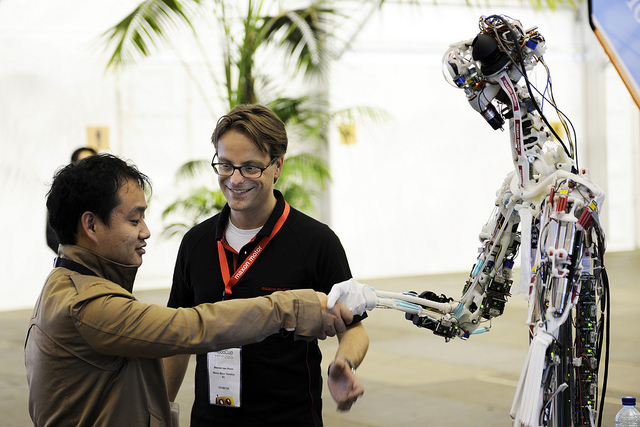Today, chatbots are helping us with many tasks that used to require human input. Many of us have experienced the use of automated answering services when calling support at a large company. Even more recently, tech companies such as Facebook and Slack have been using chatbots to answer many of the most common questions their customers may have. This shift can be seen even within more specialized customer service jobs such as that of a travel agent; companies like Expedia are now using these AI-based software assistants to provide both basic and sophisticated travel-planning assistance for their customers.
Training a Bot
In order to develop these travel bots, companies must first “train” their chatbots. A bot’s ability to communicate authentically and naturally is key; it must come across as though it is a bona-fide human correspondent. Famous computer scientist Alan Turing has said that a machine is considered to be “thinking” if it can fool a human observer into believing they have just spoken with another person. After extensive trial and error, and many mock conversations with the artificial intelligence in question, software engineers must rewrite the code behind their chatbot’s behavior, so as to ensure that they will indeed dupe a human interpreter, and therefore pass the Turing Test. A chatbot passes this test if the evaluator is unable to tell that they are talking to a machine and not to a human. As the engineer encounters the many edge cases (situations that only occur at extremes of an operating parameter) found within the set of questions that their chatbot is designed to answer, they can improve the chatbot’s ability to respond to the needs of the user, all while keeping the context of the conversation within the desired constraints.

Challenges in Travel Bot Development
The travel industry is now taking advantage of chatbot technology, but it faces challenges. In order to respond appropriately to a consumer, a virtual travel assistant must understand the context of the user’s language. If the context is ignored, it will be clear to the user that they aren’t speaking with a human who fully understands their questions. For example, the bot used by Expedia.com provides assistance to customers who want to book hotels. If a customer has just spoken with the support helpdesk and then asks the bot a question, repeating their issues may lead to confusion. Without large amounts of testing data, the travel robot may have a difficult time deciphering an ambiguous sentence or concept.
According to online testimonials, many customers get frustrated with travel bots because they can only answer common questions; they do not have access to the customer’s account information or their history. In order to create a successful bot, companies must make sure that their bots can respond to interrogation; customers must be able to ask specific questions about their orders or plans. The bot must then be able to provide tailored recommendations that show awareness of the customer’s personal information and account history
Travel bots must also be able to respond properly when they are in difficult scenarios. If the customer asks a confusing question, the bot may be stumped. The chatbot must be able to recognize the point at which it can no longer help the customer–either through time cues or an answer that seems unsure–and be able to divert the conversation to a human representative.
A Quick-Learning, Virtual Assistant
In order to be successful, a travel chatbot must use previous interactions with customers in order to hypothesize future answers; it must be autodidactic. The bot must be able to do this fast enough for the sales and support staff to quickly test the bot on a large customer audience, while simultaneously delivering basic assistance to the end user. By sending data through the neural networks of the bot–the computer’s “brain”– engineers can teach their robots how to learn for themselves. This testing and incremental improvement process leads to more organic conversations.

If the travel bot is being used heavily by many users at one moment, the company must make sure their bot is able to manage the workload without forcing a majority of users to speak to a human representative. To achieve this goal for the largest amount of users, the robot must be extensively load tested; it must be able to manage any anticipated peak in demand for the assistance of customers. If a network of bots is working efficiently and properly tweaked, it will be able to respond to all users in a timely fashion.
Revolutionizing Travel With Bots
When a travel bot runs smoothly, it can help to diminish the need for travel agents; travelers can simply use a bot to research across multiple sites and book the best deal they can find, using only automated software. Though some customers still prefer to speak to a human, if a bot works efficiently, it will appear in the guise of a travel agent.
A travel bot becomes indispensable when it can think outside the box; it must be able to access other apps, calendars, and devices. This will allow a customer to book a flight, add it to their calendar, and communicate with other travelers all through the use of a bot.
The director of emerging technologies for BCD Travel, Miriam Moscovici, predicts that in the next year, “lower-priority tasks will be handled by self-service artificial intelligence, which will free up human travel agents to do more of the intense work required.” If cognitive computing technology and natural-language capabilities keep on improving, bots will be able to manage complex requests and provide quicker, more relevant responses. With the help of bots, travel will continue to become more efficient and affordable. If a bot can deal with a majority of the lower-priority tasks, the human travel agent can focus on more complicated, specialized tasks.

Up-And-Coming Travel Bots
Check out our Ultimate List of Travel Bots.
Also: The newest travel bots on business insiderfor more information!
- Expedia.com: Facebook Messenger bot
- Skyskanner: Facebook Messenger bot
- Kayak: Slack bot that can search for flights
Great article. Thanks 🙂
Thank you! We are happy that you liked it!
Great article, Emma! What do you think of Instalocate chatbot – https://m.me/instalocate. All the existing travel chatbots focus on booking the flights, hotels etc. However, Instalocate focuses on the actual journey. Example: when a person take a flight.
Please do check out https://m.me/instalocate and http://www.instalocate.com.